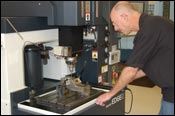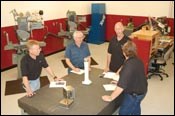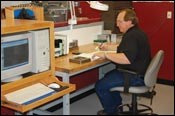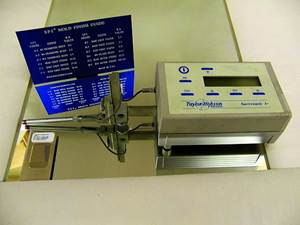Constraint Management: How to Break a Roadblock
Learning how to get the most out of what your shop has today.
Constraint Management (CM) is not a well-known topic in moldmaking circles. Basically, this renegade management philosophy is the process of identifying bottlenecks and relieving them, rather than focusing on just the process. Unfortunately, too many folks in manufacturing have been trained with a focus on processes: improve the process, improve the throughput.
This single focus on the process can perhaps be traced back to Taylorism (see Scientific Management Sidebar), which was introduced in the U.S. in the early 1900s. We as individuals—and as companies—have these concepts of efficiency ingrained in us. We have all been rewarded for process improvement in our careers. Constraint management is a new way of thinking, and involves a buy-in at both the management and employee levels for it to succeed.
Knowing Which Process to Improve
Since moldmaking involves a number of processes, and there isn’t one single operation that has a continuous, steady flow of the same type of work to schedule, CM can be useful. Your metric is noting when you start a process (whether it be a manufacturing or design process)—whatever your product is—from the time you start it until the time you deliver it. Improvement is achieved by shortening the timeline.
For moldmakers, the timeline is from the time the order is placed until the customer pays for it. So the timeline needs to be compressed with the resources available. Define the goal as being paid for a job as soon as possible.
As you look at the steps to accomplishing that, ask yourself what is keeping you from attaining that goal? How are you going to attain that goal and what is slowing you down? Those become your constraints. Constraints can be a machining process, outside materials delivery or limited manpower, or things of that nature. It is up to each shop to determine what is keeping you from getting the mold done. To make things easier to understand, you can use the term roadblock or bottleneck instead of constraint.
When you start to delve into that, you will find multiple constraints—areas in which the job gets bogged down. Look at each constraint to see what impact they have on the overall job. The worst one is the one you want to attack first. In other words, exploit that constraint by identifying it and decide what needs to be done to optimize the process so that it doesn’t slow the project down. What this does is force you to rethink the way you process a job through the shop.
You can use the methods you employ to find the root causes of quality issues to identify constraints. With quality issues, you ask why, then ask why to that answer, and repeating the process until the root cause is found. As constraints are identified, ask what will optimize the constraint. Each time something gets in the way of optimizing the constraint, ask what can be done to remove the constraint with resources available. In the example under "Putting CM into Practice," the first constraint is a limited resource. Optimizing it required optimizing a second resource.
Once the first constraint is identified and knocked loose, that will allow you to see the smaller constraints. Then, you can progressively start getting rid of those until you get to the completion of the mold. One area that is low-hanging fruit in many shops—but difficult to change—is the willingness to break setups. This is often necessary to schedule around constraints (one of the best ways of optimizing limited resource constraints). This is a major philosophical change, but the payback in schedule flexibility is worth it. Once you go through the process a few times, it becomes easier to manage. While each mold may be unique, there are certain processes required on all molds. After a few cycles of applying CM to mold builds, standard practices and procedures will evolve.
Sometimes a constraint simply cannot be eliminated, but it can still be exploited. Why have the entire shop working additional overtime if it is not going to impact the completion of the job? All this will accomplice is some heavy payroll and WIP (work in process) that will eat into your cash flow. Schedule the shop based on the true constraint.
In our shop, we typically take on entire projects of multiple parts to be run in low cavitation molds. This means we will typically have four to six molds hit our shop with the same delivery date. A tidal wave of work moves through the company—first hitting design, then CNC programming, then the CNCs, followed by EDM, and so on all the way to scheduling sample time. This creates a progression of constraints by task. Notice the absence of the words, “by department.” As a result, there is a chronological progression of constraints that occurs over and over.
One thing we have done over the years is learn to use some unorthodox scheduling to relieve constraints. Rather than take the simplest mold to “get something into the shop,” we evaluate the biggest constraint and tackle the mold with this constraint first. This way it does not become a roadblock for the other molds. Also, we do not have departments. We found that departments lead to classic Taylor metrics and false productivity gains. This means more training for moldmakers (not machine operators) to be proficient on a variety of equipment.
Putting CM into Practice
Here is a real-world example to show how CM works, focusing on a shop’s high-speed electrode machining center. Shop loading shows that there is 100 hours of electrode fabrication needed to burn 80 hours in the EDM. There is a window on the only EDM in the shop, but only for the next five days. After that, it will be two weeks to get into the EDM. CM says that machining the electrodes is the root constraint; therefore offload some of the electrode fabrication to slower machines. Assuming a two-shift operation, if you can get electrodes to the EDM by the next day, you can fit the job into the available time and save three weeks on delivery.
|
Theory of Constraints TOC is an overall management philosophy designed to continually achieve more of the goal of a system. For example, if the system is a for-profit business, then the goal is to make more money—both presently and in the future. TOC consists of the following: the five focusing steps and their application to operations; and the thinking processes and their application to project management and human behavior. According to TOC, every organization has one key constraint (i.e. a bottleneck) which limits the system’s performance relative to its goal. These constraints can fall under broad classifications of either an internal constraint or a market constraint. In order for the system to be properly managed and thus able to perform, the constraint must be identified and managed correctly (according to the Five Focusing Steps detailed below). Below are the key steps to implementing the TOC strategy:
|
Everyone will have a fit because now the electrodes will take 180 hours to make. But, we can get them done in three days and stay ahead of the EDM. The other two machines were sitting idle anyway (old less “efficient” machines), so it put very little additional true cost on the job. Yet, your time-keeping methods show you are over budget 80 hours.
The question becomes how are you going to make money logging more hours on a job? There are three ways. First, after adopting CM, the shop “magically” becomes more efficient (the wrong metrics were being used before). Second, the time between the PO and check is shortened, which equates to inventory reduction. Materials being worked on and WIP (work-in -process) labor should be treated as inventory when looking for overall efficiency in a mold shop. Reducing inventory frees up cash flow. Third, shop time is freed up. Remember the mold was delivered two weeks sooner. This means you can take in more work.
Buying into CM
It may take time for both management and employees to buy into the CM strategy. With Taylorism, one comes up with a set of rules for how shop hours are accounted for; and applying CM eliminates this step. This concept is especially difficult with toolmakers who are accustomed to being graded on how many hours are put in on a job. Therefore toolmakers are very conscious of the hours spent on the job and want to know how many hours they have spent on a job on a weekly basis. Instead, the focus should be on when the delivery date is and will that deadline be met.
The key to understanding constraint management is to recognize that any organization that has creditable management has limited resources. This is especially true of most tool shops left in the U.S. Yes, we can go to lights-out machining cells if we have the work mix to allow this and the financial strength to pull it off. CM lets us increase our productivity with the resources available (without buying new machines or hiring additional staff).
Not only does applying CM help shops attain time compression, you also will realize other benefits. Let’s say you buy into CM. Soon you will need to expand. Do you hire more moldmakers? Add a new four-axis EDM? Update your programming software? Let CM lead you to that decision. Look at what will help your greatest constraints. If you are looking at capital equipment, don’t justify it on outside hours purchased, but days that jobs were held up or quality limitations with current equipment. CM also will help you decide if you need to add staff or the current staff can become more productive with the right tools. Sales and customer service can be evaluated in a similar manner. Look at turnaround time on RFQs. What are the constraints that keep you from doing them quicker? If you apply CM techniques to evaluate decisions, then you are more likely to make a correct decision.
Embracing the Philosophy
During our first year of applying CM, I had a “wow” moment when I walked onto the shop floor to check on a job. It was a mold with a very fast turnaround time and things were a little crazy. I started to question why one of the CNCs was sitting idle, and the lead toolmaker walked up to me and calmly said, “That CNC is not our constraint.” It was then I knew the employees embraced this philosophy.
Related Content
Surface Finish: Understanding Mold Surface Lingo
The correlation between the units of measure used to define mold surfaces is a commonly raised question. This article will lay these units of measure side by side in a conversion format so that companies can confidently understand with what they are dealing.
Read MoreHow to Determine the Proper Vent Depth
Vent depth is critical to optimizing mold performance, so here is one approach to finding that elusive right number.
Read MoreWhat You Should Consider When Purchasing Modified P20 Steel
When buying P20 steels that have been modified, moldmakers must be aware of the variations and key issues that affect delivery, cost and lead times.
Read MoreThe Benefits of Hand Scraping
Accuracy and flatness are two benefits of hand scraping that help improve machine loop stiffness, workpiece surface finish and component geometry.
Read MoreRead Next
The Lean Question: How Soon Can I Get Started?
Too many moldmakers are still asking,“Is this for me?” when they should be asking, “How soon can I get started?”
Read MoreAre You a Moldmaker Considering 3D Printing? Consider the 3D Printing Workshop at NPE2024
Presentations will cover 3D printing for mold tooling, material innovation, product development, bridge production and full-scale, high-volume additive manufacturing.
Read MoreReasons to Use Fiber Lasers for Mold Cleaning
Fiber lasers offer a simplicity, speed, control and portability, minimizing mold cleaning risks.
Read More









.jpg;maxWidth=300;quality=90)














